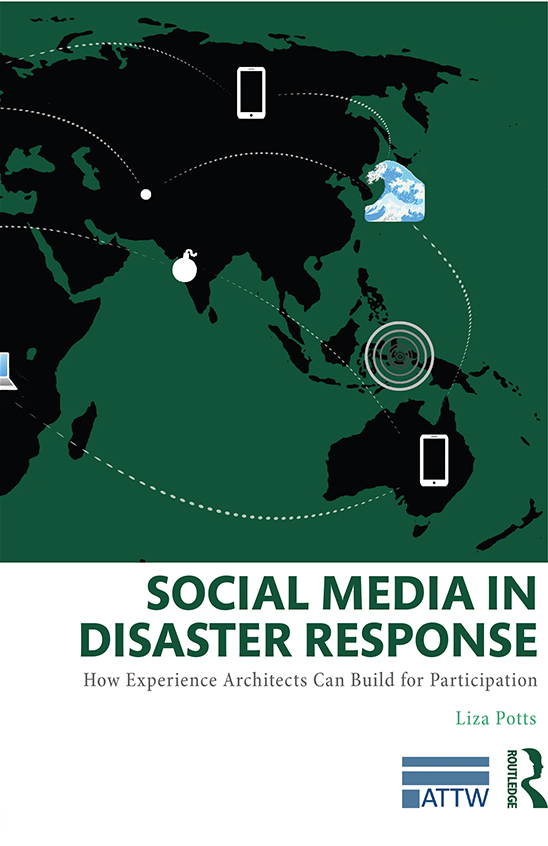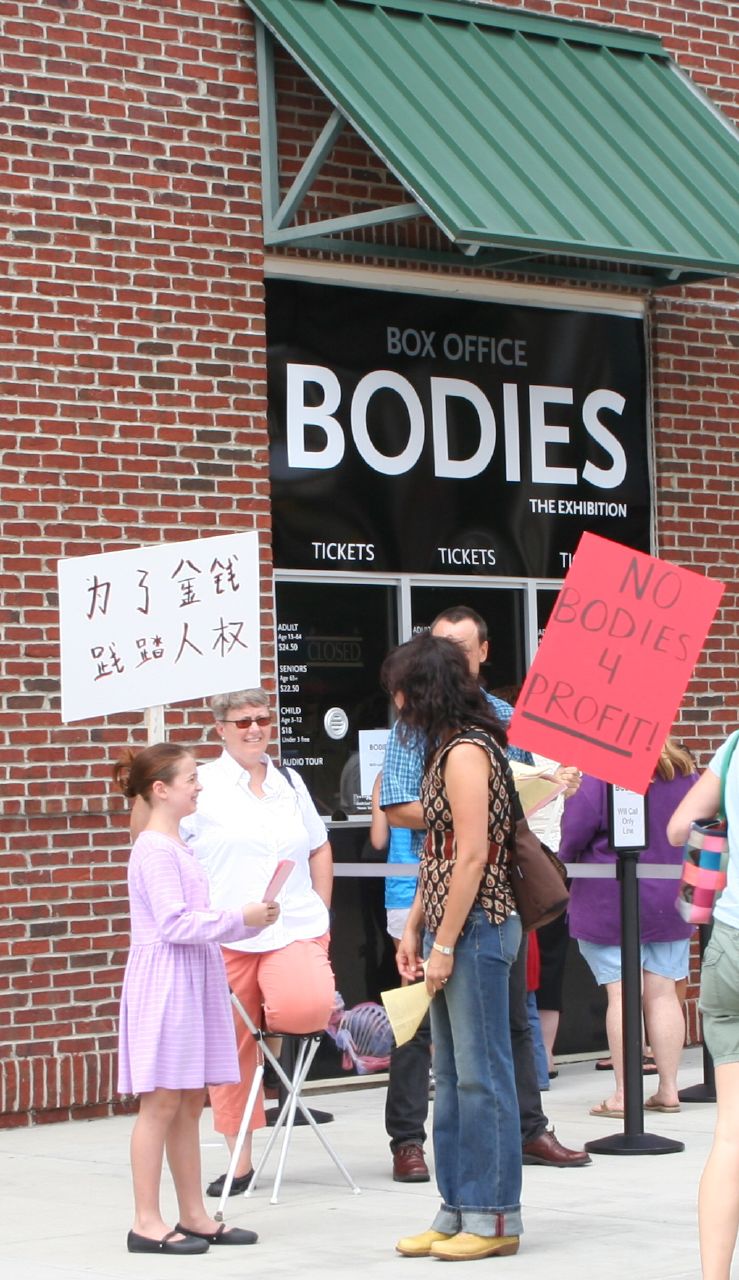Book Review: Potts’ Social Media in Disaster Response
Potts, Liza. Social Media in Disaster Response: How Experience Architects can Build for Participation. Routledge: New York, 2014. Print.
In Social Media in Disaster Response: How Experience Architects Can Build for Participation, Liza Potts argues that the processes of software and systems design can no longer focus only on users who are assumed to work within single, closed programs, but rather they must design for participants who move fluidly between multiple networks and software environments.
The book is aimed at a dual audience—technical and professional communication researchers and practitioners—and serves different purposes for each. Indeed, the title neatly addresses each audience.  For researchers, this is a book on social media and disaster response, and Potts outlines a methodology for examining the actions of participants in social environments—particularly anchor actors who she identifies as playing a key role in these environments—providing case studies of social media use in the aftermath of disasters to illustrate the effectiveness of her methods. These case studies take a wide-angle view of these disasters, mapping the connections between systems like Flickr or Google Docs. For practitioners in industry, the book argues that experience architects can—and should—build systems that encourage participation. For this audience, the book advocates for experience architects to participate in the systems that they build and to invite other participants to comment on the design of those systems, thus encouraging a greater fit between a design and its real-world implementation.
For researchers, this is a book on social media and disaster response, and Potts outlines a methodology for examining the actions of participants in social environments—particularly anchor actors who she identifies as playing a key role in these environments—providing case studies of social media use in the aftermath of disasters to illustrate the effectiveness of her methods. These case studies take a wide-angle view of these disasters, mapping the connections between systems like Flickr or Google Docs. For practitioners in industry, the book argues that experience architects can—and should—build systems that encourage participation. For this audience, the book advocates for experience architects to participate in the systems that they build and to invite other participants to comment on the design of those systems, thus encouraging a greater fit between a design and its real-world implementation.
From Users to Participants, Research to Practice
Potts frames her arguments for these two audiences within the movement from user-based design, which is focused on “one user working in one system” (20), to participant-based design that takes into account the “ecosystems”—composed of networks, software, people—that influence how participants engage particular software or systems to share information. This move from user to participant is key to the arguments in the book, and Potts defines these participants, following Jenkins, et al., as any actor or group of actors who exchange content within systems that facilitate “low barriers to civic engagement, participant and producer support for content creation and sharing, informal expert mentorship for novices, belief among members that contributions matter, and social connection among members” (Potts 25).
Building on the terminology of information architecture, Potts calls for experience architects—designers who create “the end-to-end experiences” that define how participants exchange content within multiple systems (3)—to lead teams with diverse skills to create participation-friendly systems. The particular goal of this architecting is to ensure that the “individual component” that is being designed interacts with and becomes “part of a larger ecosystem” consisting of “multiple technologies, devices, websites, organizations, people, and events” (3).
Central to this argument is the idea that professional and technical communicators with humanities backgrounds are particularly well suited to architect such systems, given the field’s “focus on persuasion, context, audience, and reception” (4). This focus prepares professional and technical communicators for embedding themselves in contexts of actual use, advocating for participant-based interventions in the design of software and information systems. For Potts, the experience in experience architecture does not simply denote the act of designing experiences for participants within social media. Rather, it suggests that architects need to be experienced with the systems they design, embedding themselves within those systems. This will enable them to both understand how those systems work in day-to-day use as well as to observe how participants exchange content, inviting those participants to comment on the design and architecture of new systems as they emerge. In making the case for professional and technical communicators to conceive of their work as experience architecture, Potts issues both a call to action to researchers—urging them to not simply observe communicators in social spaces, but also to advocate for these participants in system design—and an appeal to practitioners to include this research in their designs.
About the Book
Social Media in Disaster Response is the first book in the Association of Teachers of Technical Writing’s (ATTW) revived publishing venture. The series, titled the ATTW Book Series in Technical and Professional Communication, is edited by Jo Mackiewicz, and in her introduction Mackiewicz states that the purpose of the series is to engage both academic researchers and professional and technical communicators in industry. According to Mackiewicz, the series will be distinguished by books focused on not only academics and researchers, but also practitioners: the professional and technical researchers that the field both produces and studies. As I have stated, this focus is evident in Social Media in Disaster Response, as it explicitly courts both an audience of researchers as well as practitioners. The book is short, in a good way, tracking a trend in scholarly publishing for shorter monographs and meeting a need in technical and professional communication—a field where knowledge is mostly made at article-length—for scholarly works longer than an article but shorter than the typical 90,000 word manuscript.
After the introduction, the body of the book contains four chapters: the first describing Potts’s research and architecting methodology and the remaining three focused on individual case studies of disasters and the use of social media by participants (or would-be participants). The concluding chapter adds brief notes on social responses to disasters after the three chronicled here, arguing that these additional examples show the continuing need for participant-focused experience architecture in the design of social systems. Although Potts argues for a broad approach to both participatory systems and experience architecture, the paradigm she provides for such participation is the social web, particularly the use of social tools during times of disaster. Disasters provide a particular lens for this process, capturing the movement of content within social spaces at a time of heightened participation, and Potts argues that her three case studies—the use of social media in the aftermath of Hurricane Katrina in 2004, the London bombings of 2005, and the Mumbai attacks in 2008—allow researchers and practitioners to see how participants use social systems for exchange and enable them to use this knowledge to not only improve those systems but also to architect new systems that enable best practices for such exchange.
Actor-Network Theory and Architecting Social Systems
How, then, are researchers and practitioners to address the needs of participants when architecting systems? Because participants do not perform their work in closed systems, but move across multiple systems, Potts argues that experience architects should examine the connections that facilitate these movements, extrapolating from them to create systems that enable participation (18). Her method adopts the terminology of actor-network theory (ANT), where human participants, social systems, and technologies are treated as actors influencing the behavior of the network. Potts adapts the features of ANT to social media participation, developing a methodology that practitioners can use to examine the connections created by participants during disasters. She specifically draws on Callon’s four-step framework for tracing the translation of networks from unconnected groups to ones that have achieved punctualization, where the “group becomes greater than the sum of its parts” (63):
- problematization, the recognition by participants of an unfolding event;
- interessement, the recruiting of new actors to the network defined by the problematization;
- enrollment, when actors are persuaded of this definition of the network; and, finally,
- mobilization, where actors “validate” and share content within the network (28-29).
Within Potts’s methodology, allowing for punctualization is a key feature of participatory systems that experience architects must work to design, and much of the work in the sequence above is performed by what Potts calls “anchor actors,” actors in the network who are “more critical to the network” and have “more agency” than do other actors (68). Potts connects Callon’s framework to the development of information in networks, where content is defined as moving through three stages. First it begins as data that, when uncontextualized, is unable to provide useful information to users. The next stage, information, occurs when data is validated, for example, by connecting it to other data. Finally, information becomes knowledge when, after it is validated, it begins to be “repurpos[ed] and distribute[ed]” throughout the newly punctualized network (Potts 24).
Social media offers a unique ground for understanding the movement of content within networks. In the language of ANT, the social web offers participants “fire spaces,” stable organizations where network behaviors can form (27-28). The content in such networks exists as either mutable or immutable mobiles, the former being content that can be modified by participants or other actors in the network and the latter being content that cannot by modified (27-28). According to Potts, most social media exist as mutable mobiles that can be changed by participants, and this ability to alter content is one of the unique benefita of the social web, where “[s]tabilty emerges from” the “flexibility of social web tools” (28).
Keeping with the book’s focus on both researchers and practitioners, Potts translates this theory into tools that can be used by experience architects designing systems for participation. The primary tool is the ANT diagram, or ANT map, that can “capture the people, technologies, organizations, events, and other relevant actors” in the network (31). These maps are intended to “clarify the context” that influences participants as they “experience the system” in question (31-32). According to Potts, the design of these maps moves through three stages:
- Pinpointing the central actor or object
- Identifying relevant people, places, and things (nouns)
- Weighing relationships (32)
Further, Potts encourages the use of stencils in the maps, where stencils are images that can be stand-ins for the actors in question. Potts argues that the use of these stencils facilitates visual processing of complex networks, and provides a means of identifying similarities between the various actors in a network (multiple groups or individuals, for example) (37). These maps are intended as conversation pieces that allow the team to architect systems that support the observed participation; as Potts puts it, “[b]y mapping out the relevant people, organizations, technologies, and events, researchers and architects can better address questions of resources, use, and activity” (35).
Participant Exchange on Social Media During Disasters
Potts applies her methodology—the movement of data to information and ultimately knowledge, coupled with Callon’s four steps to punctualization—for understanding the role of participation in creating networks in the aftermath of three disasters: Hurricane Katrina, the London Bombings, and the Mumbai Attacks. In these case studies, she maps how the development of social media tools, and the subsequent participation enabled by these tools, allowed for increasingly sophisticated responses to these disasters, as measured by the ability of social media networks to support punctualization and the move from data to knowledge. Towards this end, she arranges the three primary cases to track the movement of content about each disaster from data to information to knowledge.
In the aftermath of Hurricane Katrina, Potts shows how attempts to find lost loved ones were hampered by “walled-garden” (41) approaches of traditional media that did not allow users to influence content or move it from the data stage, thus preventing them from becoming full participants. She focuses on a list of survivors compiled by CNN, the “Safe List,” that did not allow for user participation: changes were only possible by emailing the site’s moderators, and the design of the list made it difficult to find names without manually scrolling through multiple pages (48-49). As Potts notes, the technologies used to update users—CNN’s site search, RSS—did not allow for participation, and were particularly bad at keeping users up-to-date on fast-changing information (42-43). For this reason, participants could not validate the list resulting in its content staying at the level of data. Although this case stopped short of information or knowledge, by examining it experience architects are able to identify systems that prevented users from becoming full participants who could validate data into information.
Unlike the Katrina “Safe List,” the social web tools used in the aftermath of the London Bombings allowed for greater participation and the validation of data, if not yet fully allowing those participants to turn that data into knowledge. Potts documents how individuals posted images to Flickr, the online image-sharing site, and that by adding these images to a “pool” of images from the attack, they were able to generate verified information about the bombings.
Using Callon’s steps for translation, Potts argues that tools like Flickr allowed participants to problematize the event and recruit other participants to share images with the group. At this problematization stage, anchor actors appeared to establish the photo pool on Flickr and encourage other actors to participate in the network. While the social web was becoming more developed in 2005, Potts notes that many sources of information—chat room discussions, blog comments, media reports—were effectively separated from each other, thus requiring anchors to seek out this information and encourage content creators to add to the growing collection of data on Flickr. However, by using the commenting and tagging features on the site, these participants were able to validate this data by linking it with other pieces of data, but this activity stopped short of enrollment and mobilization. Potts suggests that this limitation could have been the result of tedious tasks—like finding and tagging photos—that occupied the time of anchors, and argues that experience architects could effectively intervene in similar situations by creating automated systems to complete these tasks, thus freeing up anchors for other work.
Potts argues that the full process of network translation occurred in the aftermath of the Mumbai Attacks in 2008 and this network enabled participant content to become knowledge within the community. Like the CNN “Safe List,” in the days after this series of attacks—which led to 166 civilian deaths and 304 injuries—participants collected information about survivors. Unlike the closed, difficult-to-use “Safe List,” however, anchors who responded to the Mumbai attacks utilized social tools to engage other participants, validate data about survivors, and then share the resulting information throughout their networks. As with the London bombings, after an initial problematization of the event and the recruiting of additional actors, the anchors of the response were able to enroll additional actors and mobilize them to distribute information, turning that information into knowledge within the community. Significantly, this mobilization did not occur exclusively via the use of social media like Twitter, but also included pre-Internet technologies such as fax machines. By enrolling and mobilizing other actors, these anchors were able to punctualize this hybrid network, allowing for full participation.
Concluding Thoughts
I suspect that researchers will be primarily interested in Social Media in Disaster Response for its adaptation of ANT to the development of social content and the relation of the movement of this content to network development. Potts is most persuasive in her case studies when she details how participants were able to use (or were thwarted from using) social tools to create ad hoc networks for sharing information about these disasters.
Given this focus, the book will have more appeal for researchers concerned with methodologies rather than those looking for analyses of specific social media. Although noting that closed systems prevent users from fully participating in them is not necessarily a new claim, Potts’s methodology for evaluating the participation levels of networks provides a practical framework for understanding the processes that lead to (or do not lead to) such participation, and this methodology should be applicable to analyzing a wide range of networks, social or otherwise. As diverse forms of social media have emerged over the past decade, it has sometimes been a challenge to make theoretical generalizations about them. Potts’ marriage of ANT and Jenkins et al.’s participatory culture provides a useful tool for researchers studying the kludgy networks that develop in new media spaces. For greater insight into how these networks did or did not reach punctualization, it would have been fascinating to see interviews with the anchor actors that Potts identified in her studies, but such analysis may have been beyond the scope of her project.
For practitioners, Potts provides practical responses to her studies at the end of each case study chapter, arguing that mapping the networks of anchors can identify specific impediments to knowledge sharing within networks, thus allowing experience architects to identify and then fix them. In the final chapter, she briefly addresses a number of more recent disasters, and how networks that formed in response to them met or failed to meet the needs of participants. It is not clear how the practical tools she describes—ANT maps and stencils—will be useful for most practitioners beyond simply serving as visualizations of networks. However, Potts does a convincing job arguing for the need to enable participation in the development of new systems. For an audience of practitioners, I suspect that Potts’s goal was not to advocate her particular methodologies, but rather to persuade them that participants and the researchers who study them deserve a seat at the design table. Social spaces need to be designed so that they decrease the burden of tedious tasks on anchors—for example, allowing for easy search and navigability or automating rote tasks like tagging images—but also be open enough to allow user interaction and validation. Because participants work in ecosystems of different actors, including different social media sites and other tools, Potts calls for greater openness and interoperability within these systems, offering an unspoken critique of the current trend in systems design that attempts to lock users within a single system or platform.
Interestingly, by focusing on the role of connection and participation, Potts’s argument exposes the lack of existing participatory systems to support professional and technical communication scholarship and practice. For example, in her introduction Mackiewicz states that she sees electronic books in the ATTW Series being heavily annotated by their readers, but this book is not priced in such a way as to encourage the adoption of the ebook. Copies in popular ebook marketplaces like Amazon and Apple’s Ibookstore are priced nearly the same as the paperback. (At the time of this writing, on Amazon.com it was possible to purchase the paperback—a manufactured thing that had to be printed, and shipped to a warehouse where it sat until it was shipped to me—for less than you could buy the electronic version—a computer file that could be effortlessly copied and transferred over the Internet.) A PDF of the book on the publisher’s site costs nearly twice as much as the physical copy. All of these copies come loaded with DRM, ensuring that readers’ notes and highlights remain siloed within discrete, non-interoperable platforms with strict limits on sharing and coordination among readers. That is, with strict limitations on the ability of participants to creating the networks and subsequent movement towards knowledge that Potts advocates.
This is disappointing.
Of course, the hindrances to participation in electronic book markets are not the fault of the author or the editor or the series, but rather reflect economic and publishing trends. I mention them because the confluence of this new book series with Potts’s argument for participation provides an opportunity for thinking about how the systems that support academic and industry knowledge can be changed to support greater knowledge sharing. The case studies Potts has chosen mark a transitional phase in social media. In different ways, each defined a change in how ordinary people used the Internet, from reading information produced by traditional publishers to sharing and commenting and transforming that information into the participatory culture Potts advocates. There are many good things about this new ATTW series; perhaps to its initial success the publishers could add the mission of making academic knowledge more participatory, not necessarily by changing the structure of the ebook market, but by providing tools that readers can use to render the information created within the series amenable to social, participatory knowledge.
Work Cited
- Callon, Michel. “Some Elements of a Sociology of Translation: Domestication of the Scallops and the Fishermen of St Brieuc Bay.” Power, Action and Belief: A New Sociology of Knowledge? Ed. Law, John. London: Routledge, 1986. 196-223. Print.
- Jenkins, Henry, et al. Confronting the Challenges of Participatory Culture: Media Education for the 21st Century. Cambridge, MA: MIT Press, 2009. Print.
- Potts, Liza. Social Media in Disaster Response: How Experience Architects Can Build for Participation. New York: Routledge, 2014. Print.




 John Jones is an Assistant Professor in the Professional Writing and Editing program at West Virginia University. John’s research interests include rhetoric and writing, digital studies, and professional and technical communication. Some of his recent publications include "Switching in Twitter's Hashtagged Exchanges” (2014) in the Journal of Business and Technical Communication and "Networked Activism, Hybrid Structures, and Networked Power” (2013) in Currents in Electronic Literacy.
John Jones is an Assistant Professor in the Professional Writing and Editing program at West Virginia University. John’s research interests include rhetoric and writing, digital studies, and professional and technical communication. Some of his recent publications include "Switching in Twitter's Hashtagged Exchanges” (2014) in the Journal of Business and Technical Communication and "Networked Activism, Hybrid Structures, and Networked Power” (2013) in Currents in Electronic Literacy.